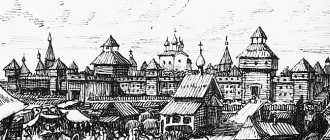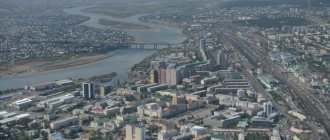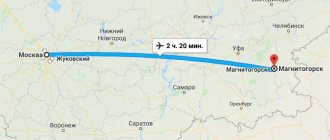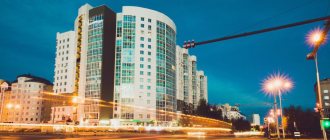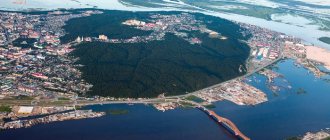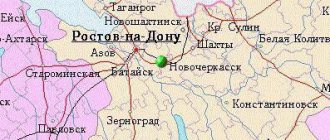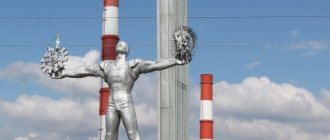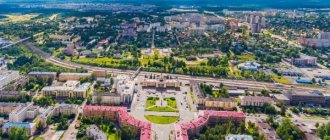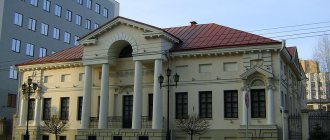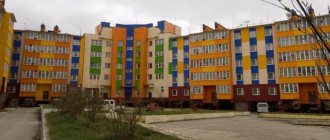Climb to the top of a lava mountain and look into the smoking mouth of a volcano, go in search of killer whales and whales, conquer inaccessible landscapes in jeeps and helicopters, and then swim in hot springs under the open sky. Listen to the hubbub of geese at bird markets, see with your own eyes the simple life of the Itelmens, Koryaks and Evens, taste the salt of the ocean and enjoy its gifts.
Kamchatka is a land that beckons with lush nature and promises bright adventures, where everyone in love with Russia dreams of visiting. Here, if you listen, you can hear the heart of the Earth beating. The project “Travel with the Russian Geographical Society” together with the tour operator RussiaDiscovery and the Vulcanarium museum offer to go to the ends of the world and explore the treasured Kamchatka from three angles - from land, water and air.
14_slashchilina_nina_-_s_dobrym_utrom_velikany_-_kamchatskii_krai_-_2020_-_524176.jpg
The calling card of Kamchatka is the recognition of its relief. Photo: Nina Slashilina, participant of the Russian Geographical Society photo competition “The Most Beautiful Country”
Kamchatka from the ground. Life among volcanoes
The transport system of the peninsula directly depends on the vagaries of the weather, which changes several times a day. The roads here are very limited, and often completely absent, so the most reliable companion for all tourists who venture outside the city limits is a Bigfoot jeep. There are many routes of varying degrees of difficulty for off-road vehicles across the peninsula. You can get to most of the volcanoes - there are more than a thousand of them, about 30 of which are permanently active. No less tempting are the constant companions of the fire-breathing mountains - thermal hot springs; the natural pools of many of them emerge right in the middle of fumarole fields - gas craters on the slopes of volcanoes.
All the lava giants were included in the UNESCO World Heritage List back in 1996 and are divided into five protected natural areas, each of which has its own list of must-see attractions.
Kamchatka for tourists: from K to A
Kamchatka is a peninsula located on the very edge of Russia. Of course, this is not his only advantage. This is a unique, wild country, the air of which is filled with the smoke of volcanoes, and hot springs gush out from under the ground, these are lakes and rocks, picturesque islands and quiet bays. The peninsula has perfectly preserved wildlife, which is why it attracts ecotourists and extreme sports enthusiasts from all over the world. Kamchatka is an excellent choice if you want to go hiking, multi-day fishing, or if you are interested in educational and adventure tours. There is something to see here, something to be inspired by and something to be surprised by - we offer you descriptions with photos of the sights of Kamchatka: study, plan your trip with us.
ekaterina_vasyagina_vremya_sozercat-525059_kronockii.jpg
Bears are the masters of the Kronotsky Nature Reserve.
Photo: Ekaterina Vasyagina, participant in the photo competition of the Russian Geographical Society “The Most Beautiful Country” Kronotsky Nature Reserve is one of the oldest biosphere reserves in Russia. Kronotskaya Sopka is an active stratovolcano and Kronotskoye Lake, the largest freshwater lake in Kamchatka. There are also unique natural objects here - the caldera (basin) of the Uzon volcano, which is a system of thousands of thermal and mud springs, and the famous Valley of Geysers.
Klyuchevskoy Park is the youngest reserve, the keeper of the highest volcano in Eurasia - Klyuchevskoy Sopka, as well as famous giants - the Kamen, Bezymyanny, Ostry and Plosky Tolbachik volcanoes. In addition, here you can find about five dozen glaciers and several hundred lava flows.
Bystrinsky Park is known for its healing thermal springs, which also heat the homes of local residents. The Beringia national sled dog racing festival takes place here, as well as several ethnographic Koryak and Even camps.
Kamchatka
Kamchatka is wonderful because there are many opportunities for recreation: climbing volcanoes, river rafting, skiing and snowboarding, fishing, animal watching, visiting national holidays - this is not a complete list. Yes, you need to take into account the harsh climate - many activities are seasonal, but there is something to do here at almost any time of the year.
Event tourism
Getting to know the traditions of the indigenous peoples of Kamchatka
© Elena Butorina
The uniqueness of the region can be felt thanks to national holidays; they make it possible to preserve the traditions of indigenous peoples and introduce tourists to them. Plan your trip to one of them, and along with the natural beauties of Kamchatka, you will receive an unforgettable experience of coming into contact with a new culture.
Reindeer Herder's Day is held on the first Sunday of March in the village of Esso. Before the start of the main events, an ancient ritual of offering to fire is performed and a traditional yurt is installed, which can be visited by each participant in the event. Of course, many come here on this day to see the spectacular event - the reindeer sled race.
The program also includes competitions in national sports, performances by national creative groups, and an entertainment program for spectators. Well, what’s a holiday without treats? Be prepared to taste venison shurpa and tea with flatbreads.
"Beringia" is a traditional Kamchatka dog sled race that has been held since 1990. This long race, which usually starts in March, covers the whole of Kamchatka and has been noted more than once by the Guinness Book of Records. “Beringia” is considered one of the most significant events in the region, because it combines a sports component and the desire to preserve the cultural characteristics of the area.
In addition, race participants carry out an important mission to deliver sports equipment, stationery, books and other necessary things to remote villages. Tourists will be interested in attending the opening of the race, where they can see dog kennels, meet their furry inhabitants, and take part in festive events - quests and competitions.
Indigenous peoples are grateful for the natural resources of their land and strive to live in harmony with nature. You can verify this on First Fish Day , which is celebrated on the first Sunday of June in Petropavlovsk-Kamchatsky. Once here, you will see the ancient rituals that the aborigines perform, luring fish into the rivers so that the catch is rich in summer and autumn. In addition, exhibitions of decorative and applied arts, ethnodiscos, and competitions are held. According to tradition, the audience is treated to fish soup.
Kainyran camp
© kiltae ha
Is it possible to celebrate New Year in summer? Yes, if you are in Kamchatka! Nurgenek is celebrated here - the beginning of the year among the Evens. In the vicinity of the village of Anavgai, those who wish can take part in dance marathons in traditional aboriginal costumes, make a wish by tying a piece of fabric on a rope wrapped around two larches. The Evens believe that the more people they treat, the better the coming year will be, so you won’t go hungry at the holiday.
Perhaps the most significant event of the summer is Volcano Day , held in August. The main locations on this day are the slopes of the Avachinsky and Kozelsky volcanoes, where master classes on preparing fish and caviar and other useful local crafts, picnics, competitions, film screenings, and playing golf in volcanic terrain are held. The most spectacular part is the competition in jeeps and motorcycles. As part of the celebration, a mass ascent to the Avacha Hill is being held, in which everyone can participate.
Alhalalalai is an unusual and melodious name for the autumn holiday that falls on the last Sunday of September. It can be translated as thanksgiving - this is the time to say thank you to nature for its harvest. In the village of Pimchakh, Itelmen rituals are held in the language of this people, and at the same time their words are translated into Russian. Spectators can take part in a dance marathon that can last several hours.
Hololo , a holiday in honor of the first seal caught, will help you get acquainted with the traditions of the Koryak people It is held on the first Sunday in November. Here you can see rituals for luring large seals - dancing to the sound of a tambourine, burning twigs greased in the fire. Festive events are held on a grand scale in Petropavlovsk-Kamchatsky, participants have the opportunity to get acquainted with the ancient culture of the Koryaks and taste local cuisine - fish soup, stew, seal shurpa.
Swimming in the thermal springs of Kamchatka
Hot springs in the Nalychevo Valley
© Roman Zharinov
There are more than a hundred hot springs in Kamchatka; swimming in them revitalizes your health and relieves fatigue after hiking. Many springs are located in the open air, which allows you to admire the marvelous area along the way.
You can swim both in warm weather and in winter; hot water will prevent you from freezing. Most popular sources:
- at the resort in Paratunka, where there are several sanatoriums
- in the Nalychevo natural park
- at the Zelenovskie Ozerki recreation center, located about 20 km from Elizovo
- Khodutkinsky, on the territory of the South Kamchatka Natural Park
- in the village of Esso.
Fishing in Kamchatka
It can be either an independent pastime or an integral part of a boat trip. You can fish on the peninsula all year round; it is famous for its fish resources. In warm weather, the most favorable period is considered to be from mid-May to early December, because at this time salmon - sockeye salmon, chum salmon, chinook salmon, pink salmon and other species - enter the rivers from the ocean. Ice fishing also has its own charm; in winter, grayling, char, flounder, and smelt bite well.
Seasonal holidays
Depending on your preferences, you can choose different options for seasonal activities.
Hiking in Kamchatka
Hiking to the Vachkazhets mountain range
© Evgenia Chekh
Travel agencies in Kamchatka offer a variety of tours, including walking tours and full-fledged hikes.
The first ones can last from one to several days and are suitable for tourists who want to see the famous natural attractions of the region, but are not ready for camping life - heavy backpacks, life in a tent camp - or can only live in this mode for a few days. For those who do not want to deprive themselves of a comfortable overnight stay, there are even tours with accommodation in modern hotels.
For tourists who are ready to test themselves and break out of their usual comfort zone, hikes have been developed with complete immersion in the wild nature of Kamchatka with all the attributes of camp life - long treks with heavy backpacks, food cooked over a fire, the absence of the benefits of civilization. But, according to many tourists, all the difficulties along the way are worth it, because how else can you really get to know the beautiful wild nature of the area. Such tours usually include climbing volcanoes, visiting local lakes and thermal springs, and observing animals in their natural habitat.
Camping
© Evgenia Chekh
The hikes are designed for different levels of training - if climbing the Avachinsky volcano does not require special skills, then to conquer the Kozelsky, Koryaksky or Vilyuchinsky volcanoes, you need special equipment, mountaineering experience and the accompaniment of an experienced guide.
One of the popular routes is a trip to the Nalychevo Park, which includes swimming in hot springs, visiting the Dzenzur volcano, picking berries that the area is rich in, and, of course, enjoying the scenery of the Nalychevo Valley.
If you are attracted by volcanoes, then you can choose tours dedicated specifically to them. For example, there are routes through the Klyuchevsky Park, which are located at a sufficient distance from civilization. In addition to climbing the Plosky Tolbachik volcano, which last erupted in 2012, they can include visiting the Mutnovsky and Gorely volcanoes, as well as getting to know other natural sites.
Helicopter excursions
Some attractions can only be reached by air - after all, cars cannot be driven through the territory of the reserves. Routes with flights over and visits to volcanoes, the Valley of Geysers and other natural complexes will leave an unforgettable impression, as truly breathtaking views open up from the air.
Beach holidays in Kamchatka
To visit Kamchatka and not see the Pacific Ocean would be a miss. Go to Khalaktyrsky beach, look at the waves, walk on the black volcanic sand. Only the most desperate dare to swim here - the water on the warmest days does not warm up above 15°C. You may be surprised, but here you can also meet surfers who are not afraid of cold water and strong waves.
River rafting
They are often combined with fishing. You can choose routes of varying complexity, one of the simplest is rafting along the Left Avacha River, more difficult ones are along the Bystraya, Opala, and Pymta rivers. For extreme sports enthusiasts, spring rafting is more suitable; at this time, the river flow speed reaches its maximum.
Ski holidays in Kamchatka
There are several bases with equipped infrastructure on the peninsula, among them: “Red Sopka”, which is located in Petropavlovsk-Kamchatsky, and “Mount Moroznaya” in the vicinity of Elizovo. Also suitable for freeride are the slopes of volcanoes - Koryaksky, Kozelsky, Vilyuchinsky. Don't forget that climbing these peaks requires mountaineering experience and equipment.
korostelev_mihail_-_lyubopytstvo_-_2018_-_382140.jpg
Bear hunting.
Photo: Mikhail Korostelev, participant in the photo competition of the Russian Geographical Society “The Most Beautiful Country” Nalychevo Park is, first of all, the “Central” cordon, a favorite place among rare tourists in the valley of the Bear Tundra with hot springs equipped for swimming. The Nalychevo thermal system is the oldest and has no analogues in the world: the water of these sources is heated by slowly cooling lava, which gives off its heat and warms up the thermal baths to 75 degrees. In addition, there are volcanoes of the Avachinskaya and Zhupanovskaya groups.
The South Kamchatka Nature Reserve is the maximum concentration of active volcanoes in Kamchatka, which are constantly changing the landscape of this area - Vilyuchinsky, Mutnovsky, Gorely, Zheltovsky, Ilyinsky. There is also the Ksudach caldera volcano, which has several crater lakes filled with thermal water. On the shore of one of them there is the so-called Hot Beach, where you can sunbathe even in winter.
In the author's Volcano Travel expeditions with volcanologist guides, the routes pass through the Avachinskaya and Gorelo-Mutnovskaya groups of volcanoes, the caldera of the Uzon volcano and the Valley of Geysers, and also involve climbing one of the largest volcanoes of the peninsula - Ichinsky.
Life among volcanoes - the active masters of these lands - left its mark on the life and customs of numerous ethnic groups living on the territory of Kamchatka. Koryaks, Itelmens, Aleuts, Evens - simple hunters and reindeer herders - identified the breath of the fiery mountains with the expression of the will of the gods. This is also why it was not customary for them to help those lagging behind or save drowning people, so as not to interfere with the spirits taking their victims. Nowadays, an atmosphere of nomadic life can be found in some surviving ethnic camps.
The significance of Kamchatka in the modern world
The peninsula has a rich history of discovery and development, features in the population of the areas, and plays a significant role in the defense of the country.
History of Kamchatka
The indigenous population of the peninsula, the Koryaks, Ainu and Itelmens, have inhabited these lands since the Stone Age. A few peoples were engaged in hunting and fishing. In the 17th century, Russian Cossacks, exploring the territory of Siberia and the Far East, reached the Kamchatka Peninsula. The fort they built appeared in 1697 on the shore of Avacha Bay.
The first ships that dropped anchor here in 1740 gave their name to the hitherto nameless fortress. Vitus Bering's expedition arrived on two ships: St. Apostle Peter" and "St. Apostle Paul." This is how the fort of Petropavlovsk-Kamchatsky appeared, which became a city in 1812.
The harsh region was studied and developed by settlers from the mainland and expeditions that contributed to the development of the region. Geological surveys discovered new mineral deposits, industrial mining and processing of seafood was carried out, and reserves of high-quality wood contributed to the development of the woodworking industry.
Since 1938, Soviet military bases appeared on the peninsula, which led to the emergence of new settlements on the coast, where submariners, anti-submarine pilots and other military specialists lived. Currently, the Kamchatka Territory has been declared a zone of advanced socio-economic development, aimed at creating new jobs.
Much attention is paid to the development of tourism in the region.
Population
The peninsula is populated extremely unevenly. With a population of 315 thousand people in the region, more than half live in Petropavlovsk-Kamchatsky. The composition of the population is diverse, the majority are Russians, indigenous peoples - less than 1%.
Cities of the peninsula
There are only 3 cities and 85 villages and towns in Kamchatka. The oldest city in the region is its capital, Petropavlovsk-Kamchatsky. Its founder is considered to be navigator I. Elagin, who was sent by V. Bering to Avacha Bay to take depth measurements in anticipation of the second Kamchatka expedition.
In addition to this work, he carried out coastal surveys and the construction of living quarters for those arriving on ships. The modern city is the industrial and cultural center of the region, where enterprises, educational institutions, theaters and museums are concentrated. The city of Elizovo with a population of 40 thousand people is located 32 km from the capital of the region.
It was founded in the mid-19th century and named after the deceased commander of a partisan detachment. The main occupations of the population are fishing and seafood processing. In recent years, much attention has been paid to the development of tourism; several recreation centers have been built in the surrounding area.
Vilyuchinsk, the smallest city in the region, is a closed area. This is a military city; a flotilla of nuclear submarines is based here. Previously, the territory was inhabited by Itelmens, whose presence here since the Stone Age is confirmed by archaeological finds.
strashno_no_prekrasno-401599.jpg
Photo: Sergey Nalivaiko, participant in the photo competition of the Russian Geographical Society “The Most Beautiful Country”
In the Koryak settlements of Eyvet, Tanynaut, Kainyran and Chau-Chiv, they will talk about the features of the fur trade, teach how to perform national dances to the accompaniment of jew's harps with tambourines and how to build yarangas - aboriginal huts. In winter, you can go dog sledding here, and in summer, you can taste healing teas made from fresh aromatic herbs against the backdrop of lakes and volcanoes.
To preserve and popularize the heritage of the Itelmen, was created . Here you can see booths - summer and winter camps on stilts, attend workshops on sewing clothes and jewelry, get acquainted with the national cuisine, and to enhance the experience - take part in shamanic rituals and walk on coals.
olga_logvinec_goryachaya_zemlya_kamchatka-491922.jpg
The Valley of Geysers is the hot land of Kamchatka.
Photo: Olga Logvinets, participant in the photo competition of the Russian Geographical Society “The Most Beautiful Country” A peculiarity of the Evens, who came to Kamchatka from Yakutia three centuries ago following the Russian discoverers, was the tradition of riding reindeer not in a sled, as other northern peoples did, but on horseback. A reconstruction of the Even camp can be seen in the ethno in Bystrinsky Park. In the summer, you can watch and take part in reindeer racing, learn how to throw a lasso and tan a skin, and you can stay overnight in one of the yaranas.
The Aleuts are one of the vanishing indigenous peoples of Russia: the majority of representatives of this ethnic group live in Alaska; according to the 2010 census, just under 500 people remain in our country. You can get acquainted with their cultural heritage in the village of Nikolskoye on Bering Island - the only settlement in the Aleutian region. In the middle of the last century, the Local History Museum was opened here, the exhibition of which tells about Kamchatka expeditions, sailors and the settlement of Kamchatka residents. The ethnographic exhibition is dedicated to traditional authentic household items of the Aleuts and traces of ancient sites of the Neolithic era.
Cultural and historical sights
"Vulcanarium"
“Vulcanarium” is perhaps the most unusual museum in Petropavlovsk-Kamchatsky. Here you can get acquainted with the volcanic processes occurring in Kamchatka, see what is happening in the depths of volcanoes, visit a lava cave and learn about the nature and ethnography of the region.
“Vulcanarium” is a private initiative; it was built by volcanologists, geology students and volunteers on the initiative of Sergei Samoilenko, an employee of the Institute of Volcanology and Seismology. The interactive, popular science, multimedia “Vulcanarium” tells a fun story about the volcanoes of Kamchatka, shows its wonders and clearly explains the phenomena occurring in this region. Many people recommend visiting the Vulcanarium before going to real volcanoes - this way, during the ascents, you will be able to pay attention to interesting nuances and observe the volcanoes, being theoretically savvy.
Ethnographic Museum in Milkovo
The museum in Milkovo is an exhibition in the ancient Itelmen settlement, dedicated to the history of the development of Kamchatka and the culture of the indigenous inhabitants. The museum opened in 1976 on the initiative of the artist Mikhail Ugrin. Here you can learn about the nature of the region and its traditional culture, about the development of Kamchatka by Russians and about the economic structure of the local population. In addition, in 1986, the Memorial Cabinet of the Itelmen poet, writer and folklorist Georgy Porotov was opened at the museum. The museum's art collection includes paintings, sculpture and graphics, objects of decorative and applied art, works of Kamchatka craftsmen and artists.
You can get to Milkovo by bus from Petropavlovsk-Kamchatsky. In addition to the museum itself, in the village you can study a model of a Siberian prison, look at the Russian watchtower and chapel.
Esso village
The village of Esso is the center of Koryak culture in Kamchatka. It is located 520 km from the capital of the region on the Bystraya River. The Koryaks are one of the indigenous peoples of the peninsula. Of course, in the village there is a local history museum where you can learn a lot of interesting things about the life and culture of this people. However, most tourists come here for the amazing views, which is why this place is called Kamchatka Switzerland. What’s even more surprising is that all the houses in the village are heated using thermal springs. And in the area there are many options for taking hot baths and relaxing among the wonderful scenery.
Camp Pimchakh
Pimchakh is a Kamchatka ethno-village inhabited by a community of Itelmens, the indigenous inhabitants of these lands. In Pimchakha you can see with your own eyes ancient national rituals, get acquainted with Kamchatka traditions and even take part in “Alhalalalai” - a ritual Itelmen holiday that marks the end of the economic cycle and gives thanks to nature.
The Pimchakh ethnocultural complex, located near the sacred Ostroy Mountain, is a piece of medieval Kamchatka, an open-air museum and a village built in the likeness of the ancient Itelmen settlements. Translated from the Itelmen language, “Pimchakh” means “light”; The Pimchakh camp is truly a wonderful, cozy and colorful place where you can drop in for a glimpse.
Tanynaut village
Tanynaut is another ethnic settlement on the territory of Kamchatka. This Koryak ethno-village is located on the shore of Lake Khalaktyrskoye within the boundaries of Petropavlovsk-Kamchatsky. On its territory there are three yurts, stylized as the homes of the indigenous inhabitants of Kamchatka: they have deer antlers, animal skins, an open-air hearth... In Tanynaut you can get acquainted with the decoration of the home and household items of the Koryaks, learn about their history and way of life.
National dances, playing the harp, local cuisine, excursion programs, competitions, performances of the Koryak ensemble - guests of the village will not be bored. In addition, they will teach you how to build a yurt and make fire, and those who wish will be able to ride horses, snowmobiles or catamarans.
On an individual trip to Kamchatka, we will develop a route specifically for you and include the most interesting places, select comfortable hotels and organize adventures that will make the trip truly special. Call us on tel. or write to [email protected] - we will tell you all the details.
The article uses photographs of Dmitry Chistoprudov and Maxim Balakhovsky
smityuk_yurii_-_kosatki_-_kamchatskii_krai_-_2020_-_509516.jpg
If bears rule the land, then killer whales are the rulers of the seas. Photo: Yuri Smityuk, participant of the Russian Geographical Society photo competition “The Most Beautiful Country”
Kamchatka from the sea. Whales and seals
The coast of the peninsula, washed by the Bering and Okhotsk seas, as well as the Pacific Ocean, is indented by a large number of picturesque bays, the rocks of which are a favorite place for bird colonies and sea lion rookeries. It’s nice to combine a vacation on a yacht with fishing or diving, but the most exciting adventure in coastal waters will be a photo hunt for killer whales and whales. You can observe the inhabitants of the oceans as part of scientific cruises, accompanied by biologists who will tell you about all the habits of sea animals.
A scientific adventure cruise along the south-eastern coast of Kamchatka on a sailing catamaran from RussiaDiscovery passes through the Avachinskaya, Bechevinskaya, Morzhovaya, Zheleznaya and Russkaya bays, introducing you to the fauna of the Pacific Ocean and the research activities of scientists. In addition to watching animals, you can go kayaking, paddling, and fishing.
Beautiful bays and islands in Kamchatka
Small and large islands, reefs protruding from the depths of the sea; bays hitting the rocky, surf-rugged coastline; picturesque and calm fjord bays, beyond which the harsh northern sea begins. And above all this splendor rise the gray peaks of the volcanoes, spitting steam, over which noisy seagulls and eagles fly. This is exactly what the Kamchatka coast seems like to a tourist. That's exactly what he is.
Avacha Bay
- Coordinates: 52.962588, 158.558029.
Avachinskaya Bay is the very place that can be seen on postcards with images of Petropavlovsk-Kamchatsky, the calling card of the peninsula. It is also called the “Gateway of Kamchatka”. In terms of size, it ranks second in the world (an area of almost 200 sq. km.), second only to the Brazilian Guanabara.
Avachinskaya Bay has a length of 24 km, and the depth of the bay itself is about 26 m. The rocks, hanging over the bay, provide it with mild and windless weather. The bay is very popular among travelers. As a rule, they come here for the amazing view that opens from the shore.
The picturesque Three Brothers rock, dormant volcanoes trembling and releasing streams of smoke from time to time, and the endless blue sky that merges with the ocean beyond the horizon. Divers also paid attention to the bay. Ship graveyards, sea grottoes, schools of fish - this is only a small part of what the waters of the bay conceal.
Starichkov Island
- Coordinates on the map: 52.776928, 158.617299.
It is located in the south of Avacha Bay, and received its name in honor of the old bird - one of the permanent inhabitants of the island. From Avachinskaya Bay you can only see emerald greenery - the entire island is covered with lush thickets of alder and meadow herbs. And only from a close distance the small reef islands-kekkurs around it become noticeable, every now and then protruding from the water.
Starichkov Island is classified as a Natural Monument of regional significance. 11 species of seabirds permanently reside and nest here, three of which - the old guillemot, the spectacled guillemot and the red-faced cormorant - are rare and small in number.
In total there are about 44 colonies. Because of this, in 1981 the island received the status of an aquatic reserve. There is an opinion among travelers that bird waste that comes into contact with a person when visiting the island brings good luck. And many try to catch her on purpose.
Russkaya Bay
- GPS coordinates: 52.423705, 158.456034.
Until the middle of the 20th century, it was called the beautiful Itelmen name Ahomten. During the Second World War it was a strategic object. American cargo ships were awaiting distribution here. Afterwards, ships entered it to refuel with fresh water or change crew. Today it is one of the most beautiful and tranquil bays of the Pacific Ocean.
It is located slightly south of Avacha Bay. Despite the fact that the north sea wind almost constantly blows on the coast, the water surface in the bay is always calm. The rocky, steep banks are densely covered with creeping herbs and shrubs, among which there are rowan, rose hips, and cranberries.
Most often divers and deep-sea fishing enthusiasts come here. Even killer whales and whales swim into the bay, not to mention other marine life. Numerous families of birds nest on the banks, and bears sometimes wander in to swim and fish. Even the water in this bay is special - clean, able to remain fresh for a long time.
olga_logvinec_zolotistye_kotiki-539251.jpg
Fur seals get their name from the gorgeous whiskers that this type of seal has, and they are also distinguished by the presence of an auricle.
Photo: Olga Logvinets, participant of the Russian Geographical Society photo competition “The Most Beautiful Country” By sea, in search of whales, you can get to the nearby Commander Islands - the tops of underwater volcanoes, the home of fur seals and red-billed puffins. The islands' intricate topography is one of the best places in the world for birdwatching, with about a million different birds nesting on the cliffs here. In the waters of the Commanders you can find about 20 species of whales: gray, humpback, Japanese, sperm whales. You can watch giant mammals here all year round.
Flora and fauna
There are 1,200 plant species growing in Kamchatka. The most common tree is the Erman birch. There are larches, spruces and firs. You can find bird cherry, elderberry and rowan. The peninsula is famous for wild berries. Blueberries, crowberries, lingonberries, cranberries, cloudberries, princelings, redberries grow here in abundance - you can’t list them all! Local grasses are so lush and tall that they sometimes form thickets up to three meters high.
As befits a coastal region, the main asset of Kamchatka is fish and other inhabitants of the underwater world. Along the coast there are a lot of shellfish, shrimp, and huge crabs. There are seals, walruses, fur seals. The fish is represented by the families of flounder, cod, smelt, greenling, salmon and others. The rivers are no less rich in fish. They contain grayling, omul, char, mykiss and other “delicacies”.
Kamchatka has a huge deposit of red caviar
The owners of the taiga and the main fishermen are bears. During the spawning period, up to two hundred clubfoot can gather on the banks at the same time. They are passionate about salmon fishing. If fishing is successful, a feast is held right on the shore. Animals are not afraid of humans, so extreme caution should be used. But the vivid impressions of bear fishing will never be forgotten.
Master of the taiga
It is worth mentioning the fauna of the Commander Islands, which belong to Kamchatka. This is the rare case when the fingers of one hand are enough to count the inhabitants of the animal world. Here you can find blue fox, red vole, gray rat, American mink and reindeer. But in coastal waters there are as many as twenty species of whales - sperm whales, killer whales, humpback whales and others.
andrei_belavin_syorfing_na_kamchatke-552254.jpg
Surfing in Kamchatka is a test of yourself.
Photo: Andrey Belavin, participant of the Russian Geographical Society photo competition “The Most Beautiful Country” Water sports enthusiasts will find many activities in Kamchatka. The most unobvious way to catch adrenaline is surfing. They started catching waves on local beaches about 10 years ago, but during this time the 15-meter waves of the Pacific Ocean managed to win their regular audience. The main surf spots can be found on Khalaktyrsky beach, covered with volcanic sand, located half an hour from Petropavlovsk-Kamchatsky. The water temperature, even in summer, rarely exceeds 15 degrees: the cold waters of the ocean attract those who like to test themselves. There are no populated areas nearby, but several surf camps are set up here during the season.
Where is Kamchatka located and the origin of its name
Kamchatka on the map of Russia occupies 2.8% of the territory. A huge peninsula in the northeast of the country, stretching 1200 km almost exactly to the south. Kamchatka and the Kuril Islands, which extend it, separate the Sea of Okhotsk from the Pacific Ocean. The Kamchatka region, with its center in Petropavlovsk-Kamchatsky, was formed in 2007 by the annexation of the Koryak Autonomous Okrug to the Kamchatka region.
The peninsula got its name from the river of the same name. The toponym “Kamchatka” first appears in 1667 on a map of Siberia drawn by S.U. Remezov by order of the governor of Tobolsk P.I. Godunov. Historians have put forward dozens of theories to explain this name.
One of them suggests that the river received its name from the name of matter. Silk fabric was called “Kamchatka” in Rus' because it was brought from China, from “Kama Khan”. This theory was confirmed after the discovery of Witsen’s map, which contains “Damast River”, translated from Dutch as “Kamchataya River” (under Peter I, such fabric was brought through Damascus, so it was called “damask”).
andrei_belavin_zemlya_vulkanov-551815_s_vertoleta.jpg
Weather conditions often play into the hands of the cosmic landscapes of Kamchatka. Photo: Andrey Belavin, participant of the Russian Geographical Society photo competition “The Most Beautiful Country”
Kamchatka from the air. Alien landscapes
A helicopter in Kamchatka is the second most popular method of transportation after an SUV: everything that cannot be reached by land can be seen from the air. The most popular rotorcraft on the peninsula is the Mi-8, with a capacity of up to 20 people - a kind of flying bus, ready to take you to any height. Some protected areas, such as the Valley of Geysers, can be reached entirely by air; driving around the Kronotsky Nature Reserve is also prohibited.
From above, the landscape of the peninsula looks different: volcanic craters and fumarole fields form unearthly landscapes. Bizarrely smoking geysers, calderas of all colors, cones of young volcanoes growing from the womb of older ones, the destroyed craters of which are filled with blue-green water. You can explore the main attractions of Kamchatka from a helicopter in a week, while moving around on your own can take several months.
Kamchatka hits
Geysers are cousins of volcanoes. The former spew boiling water, the latter – magma. They are often close neighbors. They are generated by the hot bowels of the earth. The Geyser family comes from Iceland. This was the name given to the springs that periodically emitted fountains of hot water. "Geyza" means "to gush" in Icelandic.
Russian Kamchatka has many volcanoes. This means there must be geysers! The way it is. There is even a whole Valley of Geysers. There is no other like it on the Eurasian continent. And in the world, Kamchatka is considered the largest. The natural miracle was discovered in 1941. Tourists from all over the world come to see it.
Geyser
The valley is part of the Kronotsky Nature Reserve. In addition to geysers, there are thermal springs and mud pots in which liquid mud gurgles. In total, there are 50 springs and 40 geysers on a four-kilometer stretch. In a second, 250 liters of liquid pour out from the depths!
Local landscapes seem to be borrowed from another planet. The valley is decorated with round craters with turquoise water and cone-shaped wells. The soil is colored yellow, red and white. The place is very unusual, which is why parts of the famous science fiction film “Sannikov Land” were filmed here.
Thermal source
In 2008, the Valley of Geysers was included in the honorary list of the “Seven Wonders of Russia”. Tourists are brought here by helicopter. On the way from above you can admire the Karymsky and Maly Semyachik volcanoes. It is allowed to move around the reserve only on wooden platforms. The observation decks offer fantastic views! This is impossible to forget.
matveev_aleksei_-_manyashchii_bereg_-_2020_-_480605_vertolet.jpg
From the height of birds' flight, the real beauty of the Kamchatka mountains and lakes is revealed. Photo: Alexey Matveev, participant of the Russian Geographical Society photo competition “The Most Beautiful Country”
You can fly through the “home” volcanoes and the Zhupanovskaya group ridge to the Karymsky and Maly Semyachinsky volcanoes and study various manifestations of modern volcanism as part of a Volcano Travel tour, where you will be accompanied by volcanologists.
In addition to the lava giants, the owners of the Kamchatka land are bears. It is also convenient to observe them from a helicopter; their largest population - about 250 individuals - is concentrated in the area of the crater Kuril Lake, formed as a result of a tectonic depression more than eight thousand years ago. Also from a helicopter you can see the Heart of Alaid, a pink volcanic island located in the center of the lake, which is associated with many legends. The Alaid volcano itself is located in the Sea of Okhotsk, where, according to legend, it was forced to retire so as not to block the sunlight with its height, but its heart remained in Kamchatka.
Julia Gopius
On the edge of the world
The Kamchatka Peninsula is located in the northeast of the Eurasian continent. It is connected to the mainland by a narrow isthmus called Parapolsky Dol. From the west it is washed by the waters of the Sea of Okhotsk. The Pacific Ocean splashes from the east. The length of the peninsula exceeds 1200 kilometers. By Russian standards this is not a very long distance, but by European standards it is very impressive. For example, Germany is a fairly large country, but its length along the long side is less than Kamchatka!
Pacific Ocean
In 1651, one of the first Russians to visit Kamchatka was the explorer Mikhail Stadukhin, who was looking for access to the Penzhina River. This happened after a two-month rafting trip down the Anadyr River. A little later, Cossack Leonty Fedotov and businessman Sava Anisimov Seroglaz visited these places. At the beginning of the 18th century, the navigator Vitus Bering circumnavigated Kamchatka on a ship. The history of the region at the beginning of the 20th century is well represented in the film “Wealth,” based on the novel of the same name by Valentin Pikul.
Now these lands are officially called the Kamchatka Territory. You can’t find a person in Russia who hasn’t heard anything about him. It is surprising that with such fame, no one knows exactly how the name Kamchatka appeared. Today there are more than 20 versions of its origin! There are probably no analogues to this toponymic riddle.
Some believe that the peninsula was named after the Russian pioneer Ivan Kamchaty. Others claim that the name came from the Kamchatka River (then why was the river called that?). There is a version that the name is derived from the Yakut word “khamchakky” - “smoking pipe”. Numerous Kamchatka volcanoes could indeed give rise to such an analogy.
The peculiarities of Kamchatka weather are largely determined by the geographical location and terrain. In the central part of the peninsula, fenced off by high mountains, it is much warmer than on both coasts, blown by the winds. In the east, the weather can change rapidly. The heat suddenly gives way to cold rain. But after a couple of hours, “late autumn” again turns into sunny “summer”.
Winter in Kamchatka
While winter on the coast is mild, away from the ocean it is colder and windier. In the north of the peninsula, snow appears in September, and in the south only at the end of October. During the summer months, the east coast is hot, but the center is cool. The highest temperature recorded in Kamchatka is + 34 degrees, and the lowest is minus 26 degrees. Throughout the year, the peninsula is dominated by winds that cause storms. Most often they rage in the south.
There are many rivers and streams on the peninsula
Kamchatka has a fairly dense river network, which is fed by glaciers in the mountains. Therefore, the water in them is clean. The largest river is called Kamchatka. In addition to it, there are another dozen and a half rivers. Rafting enthusiasts have long mastered the Avacha and Malkinskaya Bystraya rivers. There are also 14 lakes on the peninsula. Kronotskoye Lake is considered the largest. Some of the reservoirs are located in the craters of extinct volcanoes.
